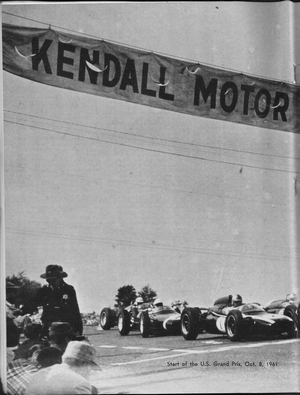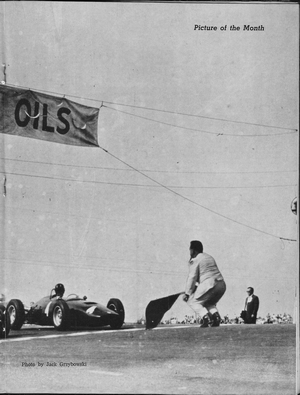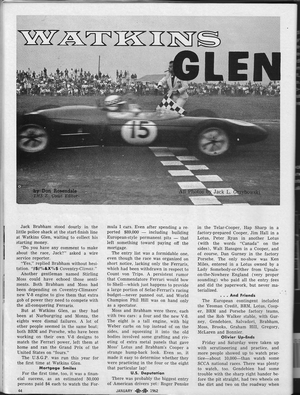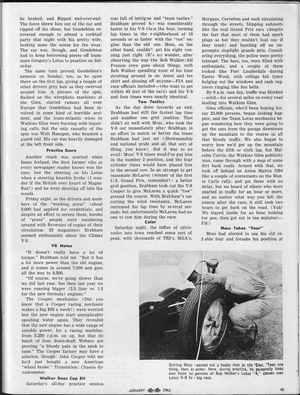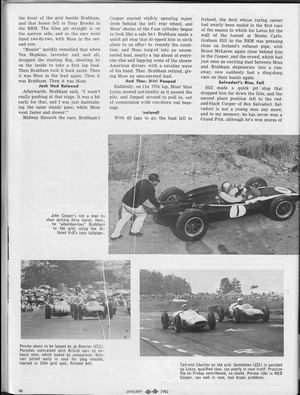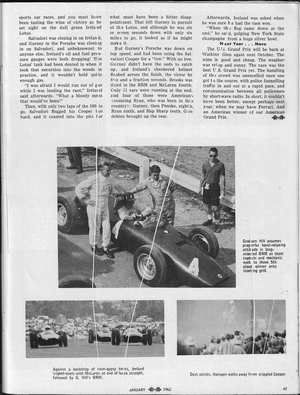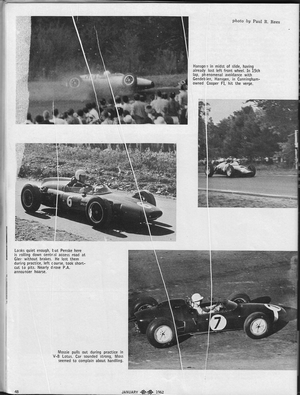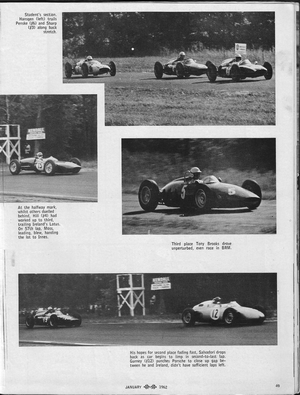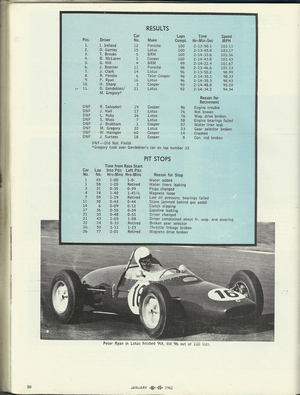|
By accessing/using The Crittenden Automotive Library/CarsAndRacingStuff.com, you signify your agreement with the Terms of Use on our Legal Information page. Our Privacy Policy is also available there. |

Watkins Glen
|
|---|
|
|
Watkins Glen
Don Rosendale, TMS E. Coast Editor
Today's Motor Sports, January 1962
Photos by Terence Semple
September 30, 1961
Jack Brabham stood dourly in the little police shack at the start-finish line at Watkins Glen, waiting to collect his starting money.
"Do you have any comment to make about the race, Jack?" asked a wire service reporter.
"Yes," replied Brabham without hesitation. "#$%&X%$ Coventry-
Climax."
Another gentleman named Stirling Moss could have echoed those sentiments. Both Brabham and Moss had been depending on Coventry-Climaxes' new V-8 engine to give them that extra gob of power they need to compete with the all-conquering Ferraris.
But at Watkins Glen, as they had been at Nurburgring and Monza, the eights were dismal failures. A lot of other people seemed in the same boat; both BRM and Porsche, who have been working on their own V-8 designs to match the Ferrari power, left them at home and ran the Grand Prix of the United States on "fours."
The U.S.G.P. was run this year for the first time at Watkins Glen.
Mortgage Smiles
For the first time, too, it was a financial success, as an estimated 50,000 persons paid $4 each to watch the Formula I cars. Even after spending a reported $89,000 — including building European-style permanent pits — that left something toward paying off the mortgage.
The entry list was a formidable one, even though the race was organized on short notice, lacking only the Ferraris, which had been withdrawn in respect to Count Von Trips. A persistent rumor that Commendatore Ferrari would bow to Shell—which just happens to provide a large portion of Sefac-Ferrari's racing budget—never panned out, and World Champion Phil Hill was on hand only as a spectator.
Moss and Brabham were there, each with two cars: a four and the new V-8. The eight is a tall engine, with big Weber carbs on top instead of on the sides, and squeezing it into the old bodies involved some grafting and riveting of extra metal panels that gave Moss' Lotus and Brabham's Cooper a strange hump-back look. Even so, it made it easy to determine whether they were practicing in the four or the eight that particular lap!
U.S. Deputation
There was probably the biggest entry of American drivers yet: Roger Penske in the Telar-Cooper, Hap Sharp in a factory-prepared Cooper, Jim Hall in a Lotus, Peter Ryan in another Lotus (with the words "Canada" on the sides), Walt Hansgen in a Cooper, and of course, Dan Gurney in the factory Porsche. The only no-show was Ken Miles, entered in a Lotus owned by a Lady Somebody-or-Other from Upsala-on-the-Nowhere England (very proper sounding) who paid all the entry fees and did the paperwork, but never materialized.
. . . And Friends
The European contingent included the Yeoman Credit, BRM, Lotus, Cooper, BRM and Porsche factory teams, and the Rob Walker stable, with Gurney, Gendebien, Salvadori, Brabham, Moss, Brooks, Graham Hill, Gregory, McLaren and Bonnier.
Olivier Up-Ends
Friday and Saturday were taken up with scrutineering and practice, and more people showed up to watch practice—about 10,000—than watch some SCCA national races. There was plenty to watch, too. Gendebien had some trouble with the sharp right handed before the pit straight, had two wheels on the dirt and two on the roadway when he braked, and flipped end-over-end. The force threw him out of his car and ripped off his shoes, but Gendebien recovered enough to attend a cocktail party that night with his pretty wife, looking none the worse for wear. The car was, though, and Gendebien had to keep borrowing pieces off of teammate Gregory's Lotus to practice on Saturday.
The same turn proved Gendebien's nemesis on Sunday, too, as he spun there on the first lap, giving a couple of other drivers grey hair as they swerved around him. A picture of the spin, flashed on the wirephoto machines at the Glen, started rumors all over Europe that Gendebien had been involved in some kind of horrible accident, and the trans-Atlantic wires to Watkins Glen were burning with inquiring calls, but the only casualty of the spin was Walt Hansgen, who brushed a guard rail. His car was heavily damaged at the left front side.
Practice Scare
Another crash was averted when Innes Ireland, the Scot farmer who as every newspaper reader knows won the race, lost the steering on his Lotus when a steering knuckle broke (I wonder if the British ever heard of Magnaflux?) and he went shooting off into the woods.
Friday night, as the drivers and members of the "working press" (about 3,000 had applied for credentials, and despite an effort to screen them, hordes of "press" people were wandering around with Brownies of copies of their circulation: 23 magazines) Brabham seemed enthusiastic about the Climax V-8.
V8 Notes
"It doesn't really have a lot of torque," Brabham told me. "But it has a lot more power than the old engine, and it comes in around 7,000 and goes all the way to 8,500.
"Of course, we're going slower than we did last year, but then last year we were running bigger (2.5 liter vs. 1.5 for the new formula) engines."
The Cooper mechanics (Did you know that a Cooper racing mechanic makes a big $28 a week?) were worried lest the new engine start inexplicably spouting water again. They revealed that the new engine has a wide range of usable power, for a racing machine, from 5,250 r.p.m. on up, but that its batch of four down-draft Webers are proving "a bloody pain in the neck to tune." The Cooper factory may have a solution, though: John Cooper told me he'd just bought a new American "wheel brake." Translation: Chassis dynamometer.
Walker Does Cop Bit
Saturday's all-day practice session was full of intrigue and "team tactics." Brabham proved he was considerably faster in his V-8 than the four, turning lap times in the neighborhood of 10 seconds or so faster with the "vee" engine than the old one. Moss, on the other hand, couldn't get his eight running just right (It's no wonder, after observing the way the Rob Walker/Alf Francis crew goes about things, with Rob Walker spending most of his time strutting around in an Ascot and tee shirt and shooing off anyone—FIA and race officials included—who want to get within 43 feet of the cars) and his V-8 and four times were nearly identical.
Tow Tactics
As the day drew towards an end, Brabham had still the fastest lap time and number one grid position. That didn't sit well with Moss, who took the V-8 out immediately after Brabham in an effort to match or better the times Brabham had just set (Showmanship and national pride and all that sort of thing, you know). But it was to no avail: Moss' V-8 times would've put him in the number 2 position, and the four cylinder times would have placed him in the second row. In an attempt to get teammate McLaren (winner of the first U.S. Grand Prix, remember?) a better grid position, Brabham took out the V-8 Cooper to give McLaren a quick "tow" around the course. With Brabham's car cutting the wind resistance, McLaren increased his lap time by several seconds, but unfortunately McLaren had no one to tow him during the race.
Color
Saturday night, the influx of
aficionados into town reached some sort of peak, with thousands of TR3's, MGA's, Morgans, Corvettes and such circulating through the streets, blipping exhausts like the real Grand Prix cars (despite the fact that most of them had spark plugs so hot they couldn't foul one if they tried) and hustling off on impromptu stoplight grands prix. Considering everything, the police were pretty tolerant. The bars, too, were filled with enthusiasts, and a couple of them looked like Fort Lauderdale during Easter Week, with college kid types bulging out the windows and cash registers ringing like fire bells.
By 9 a.m. race day, traffic was blocked—solid—for several miles on every road leading into Watkins Glen.
Glen officials, who'd been hoping for, say 25,000 persons, began looking happier, and the Team Lotus mechanics began wondering how they were going to get the cars from the garage downtown up the mountain to the course in all that bloody traffic. We also began to worry how we'd get up the mountain before the fifth or sixth lap, but Malcolm Currie, the Watkins Glen publicity man, came through with a map of some dirt back roads. Armed with that, we took off behind an Aston Martin DB4 like a couple of contestants on the Monte Carlo rally, and got there with no delay, but we heard of others who were snarled in traffic for an hour or more, and no matter what way you left the course after the race, it still took two hours to get back on the road. (Yuk! We stayed inside for an hour looking for
you, then got out in ten minutes!—Ed.)
Moss Takes "Four"
Moss had elected to use his old reliable four and forsake his position at the front of the grid beside Brabham, and that honor fell to Tony Brooks in the BRM. The Glen pit straight is on the narrow side, and so the cars were lined two-by-two, with Moss in the second row.
"Mossie" quickly remedied that when Tex Hopkins, lavender suit and all, dropped the starting flag, shooting by on the inside to take a first lap lead. Then Brabham took it back again. Then it was Moss in the lead again. Then it was Brabham. Then it was Moss.
Jack Had Relaxed
Afterwards, Brabham said, "I wasn't really pushing at that stage. It was a bit early for that, and I was just maintaining the same steady pace, while Moss went faster and slower."
Midway through the race, Brabham's Cooper started visibly spouting water from behind the left rear wheel, and Moss' choice of the four cylinder began to look like a safe bet. Brabham made a quick pit stop that dropped him to sixth place in an effort to remedy the condition, and Moss forged into an uncontested lead, nearly a lap ahead of everyone else and lapping some of the slower American drivers with a cavalier wave of his hand. Then Brabham retired, giving Moss an uncontested lead.
Ireland!
With 43 laps to go, the lead fell to Ireland, the Scot whose racing career had nearly been ended in the first race of the season in which his Lotus hit the wall of the tunnel at Monte Carlo. Graham Hill in the BRM was pressing close on Ireland's exhaust pipe, with Bruce McLaren again close behind him in the Cooper, and the crowd, which had just seen an exciting duel between Moss and Brabham degenerate into a runaway, now suddenly had a ding-dong race on their hands again.
Salvadori's Rise, Fall
Hill made a quick pit stop that dropped him far down the lists, and the second place position fell to the red-and-black Cooper of Roy Salvadori. Salvadori is not a young man any more, and to my memory, he has never won a Grand Prix, although he's won scores of sports car races, and you must have been tasting the wine of victory as he set sight on the dull green Ireland Lotus.
Salvadori was closing on Ireland, and Gurney in the Porsche was closing on Salvadori, and unbeknownst to anyone else, Ireland's oil and fuel pressure gauges were both dropping! The Lotus' tank had been dented in when it took that excursion into the woods in practice, and it wouldn't hold quite enough gas.
"I was afraid I would run out of gas while I was leading the race," Ireland said afterwards. "What a bloody mess that would have been!"
Then, with only two laps of the 100 to go, Salvadori flogged his Cooper too hard, and it coasted into the pits for what must have been a bitter disappointment. That left Gurney in pursuit of the Lotus, and although he was six or seven seconds down with only six miles to go, it looked as if he might make it.
But Gurney's Porsche was down on top speed, and had been using the Salvadori Cooper for a "tow." With no tow, Gurney didn't have the suds to catch up, and Ireland's checkered helmet flashed across the finish, the victor by five and a fraction seconds. Brooks was third in the BRM and McLaren fourth. Only 11 cars were running at the end, and four of those were Americans (counting Ryan, who was born in this country): Gurney, then Penske, eighth, Ryan ninth, and Hap Sharp tenth. Gendebien brought up the rear.
Afterwards, Ireland was asked when he was sure he had the race won.
"When the flag came down at the end," he said, gulping New York State champagne from a huge silver bowl.
Next Year . . . Move
The U.S. Grand Prix will be back at Watkins Glen again next October. The wine is good and cheap. The weather is crisp and sunny. The race was the best U.S. Grand Prix yet. The handling of the crowd was unexcelled once one got to the course, with police funnelling traffic in and out at a rapid pace, and communication between all policemen by short-wave radio. In short, it couldn't have been better, except perhaps next year, when we may have Ferrari. And an American winner of our American Grand Prix.

















 Topics: United States Grand Prix
Topics: United States Grand Prix
